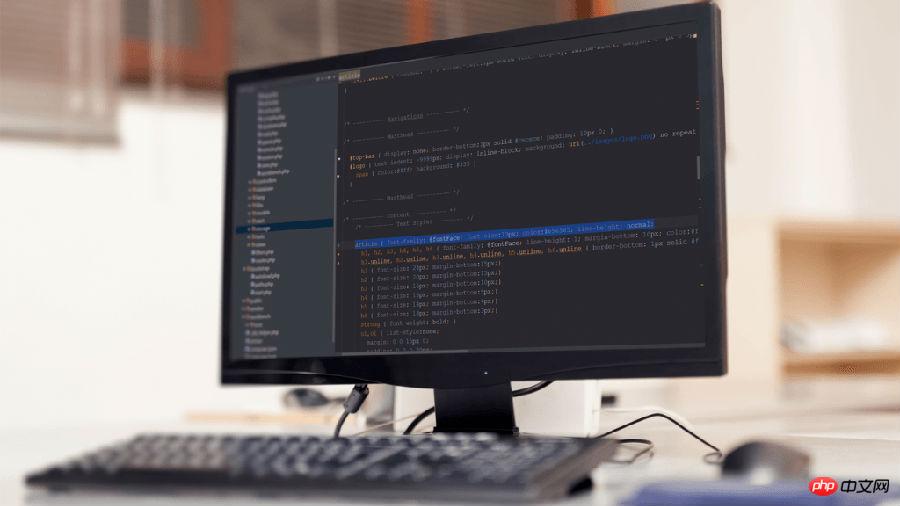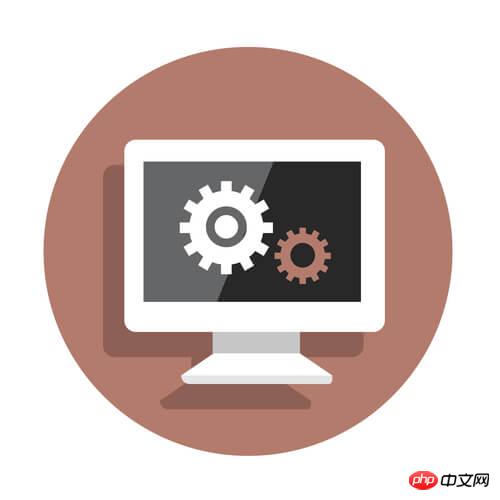 headlines
headlines
 What is backend development? The role of back-end development and the technologies that need to be learned
What is backend development? The role of back-end development and the technologies that need to be learned
What is backend development? The role of back-end development and the technologies that need to be learned
Preface:What is back-end development? What does back-end development mainly do? What do you need to learn about back-end development? GeneralA normal WEB development is generally divided into front-end development and back-end development! Front-end development is mainly a static user interface plus some dynamic effects, and does not involve data logic! For example: a login page: Front-end development only needs to complete the static page part, plus the color change when the mouse moves into and out of the input box; (please refer to the previous article: What is web front-end development? 2017 Prospects for front-end engineers ) However, if you enter the user name and password to log in to the system, you need to connect to the database, which requires back-end development for logical processing! So today php Chinese website will introduce to you in detail what back-end development is!
Text:
Software applications are like icebergs. The user only sees a portion of the application - and in most cases - the largest part of the application is invisible. This is the elusive and mysterious "back end."
In the chapter on web development, we mainly discuss web development because it involves direct interaction with end users - we can call it "front-end web development".
In most applications, there is much more non-user interface code than user interface code. A complex system is all the logic that happens in the background to make it work.
We need to store and retrieve data, we need to follow business logic and rules, and we need to predict the results. All of this happens behind the scenes.
Backend developers are such developers.
What exactly is backend development?
The purpose of this article is that I will consider backend development as a development that does not involve creating and generating user interfaces . This may include backend web development, but may also involve writing APIs, creating libraries or working with system components without a user interface or even a scientific programming system.

In reality, even though front-end development gets most of the glory, most of the code that exists in the world (arguably the most useful code) is that end users never You won't see the backend code.
Simply put, back-end development is code written by developers that cannot be directly seen.
What does a backend developer mainly do?
What a backend developer does varies greatly depending on the size and scope of the application they are working on. . When I was a backend developer, I did a lot of work on business logic in applications, as well as extracting and retrieving data from the frontend.
In the web development world, most backend developers are engaged in building the actual logic behind the applications they are working on.
Typically, front-end developers build the user interface, while back-end developers write the code to make it work.
For example, a front-end developer creates an interface in an application with a button that can be pressed to get the customer's data.
The backend developer writes the code that makes the button work by indicating what data to pull from the database and pass it back to the frontend (and ultimately display it there).
Backend developers may also be heavily involved in system architecture, deciding how to organize the system's logic so that it can be maintained and operated properly.
He may be involved in building a framework or system architecture to make it easier to program. Backend developers spend more time implementing algorithms and solving problems than frontend developers.
I have always liked back-end development work because it is more of a challenge.
This is not to say that front-end developers don't solve hard problems, but often front-end development jobs are more about creating the user interface and the content associated with it than implementing the actual business logic that makes the application work.
Related tutorial recommendations:php Chinese website php practical video tutorial
What do you need to learn for back-end development? (Major Technologies and Skills in Back-End Development)
Front-end developers need to know a range of tools for creating user interfaces, while back-end developers typically use an entirely different set Tools and skills to do their jobs efficiently.
One of the important skills needed for backend developers relates to SQL and databases. Most backend systems require a connection to the database where the application data is stored.

Backend developers usually work on writing, reading, and processing data from a database or other data source, so having skills such as SQL is very important. Backend developers - at least for web development - also need to be good at the server-side languages of the technology stack they are using.
For example, while front-end web developers focus more on HTML, CSS, and JavaScript, back-end developers need to know more about PHP web frameworks, Ruby on Rails, ASP.NET MVC or whatever is being used Server-side web development framework for building applications. Related tutorial topic recommendations: php self-study tutorial from entry to proficiency
Finally, I want to say that back-end developers need to know more about application architecture, because Most of the time, backend developers are required to build the architecture and internal design of the application.
A good backend developer knows how to use various frameworks and libraries, how to integrate them into an application, and how to structure code and business logic in a way that makes the system easier to maintain. .
If you enjoy designing application infrastructure, implementing algorithms and logic, and working with data, then you may enjoy becoming a backend developer.
Extended knowledge
About full stack developers?
What is full stack development? Please refer to: How to become an excellent full-stack engineer by self-study?

#In fact, full-stack development involves handling all components and layers of a system or software development stack. It might even involve understanding server hardware and architecture, or being considered DevOps.
Today, more and more software development positions are looking for developers who can do full-stack development, because it is valuable for software developers to be able to work on the entire technology stack involved, not Separate front-end development and back-end development.
Part of the reason is that more and more applications are blurring the lines between front-end and back-end development.
Many popular JavaScript frameworks, such as Angular, allow you to create much of what can be considered business logic in the user interface portion of the system.
Additionally, as more and more teams adopt agile methods, individual programmers are required to work in more than just their areas of expertise, as tasks are assigned to teams far more than to individuals.
I think being a full-stack developer is useful - and that you should fully understand what is going on at every level of the software - but I don't think being a "specialized" full-stack developer is the best idea, since this is not a professional field.
Basically, you should focus on gaining broad knowledge of the most common technology stacks you are likely to use, but you should pick one or two major specializations and then really go in the direction of your choice Delve deeper.
All software developers should know how to create user interfaces, the basics of the frameworks used, how to store and retrieve data from the database in the application, and even understand how the infrastructure supports the software, they do not need to be Experts in all of these fields, because these fields are not only quite large but also growing.
It may be much better to have all the knowledge that is common and valid in the technology stack or to have specialized knowledge in some areas.
Then, you can still call yourself "full stack", but in reality, talents like you are much more useful to the team.
[Related recommendations]
1.Brothers PHP Video Tutorial: The latest "Brothers PHP Video Tutorial" in 2017 recommended
2. Yan Shiba PHP Video Tutorial: The latest collection of Yan Shiba PHP related video tutorials in 2017
5.Li Yanhui PHP Video Complete collection of tutorials: 2017 "Li Yanhui PHP Video Tutorial" Selections

Hot AI Tools

Undresser.AI Undress
AI-powered app for creating realistic nude photos

AI Clothes Remover
Online AI tool for removing clothes from photos.

Undress AI Tool
Undress images for free

Clothoff.io
AI clothes remover

Video Face Swap
Swap faces in any video effortlessly with our completely free AI face swap tool!

Hot Article

Hot Tools

Notepad++7.3.1
Easy-to-use and free code editor

SublimeText3 Chinese version
Chinese version, very easy to use

Zend Studio 13.0.1
Powerful PHP integrated development environment

Dreamweaver CS6
Visual web development tools

SublimeText3 Mac version
God-level code editing software (SublimeText3)

Hot Topics
 1387
1387
 52
52
 PHP format rows to CSV and write file pointer
Mar 22, 2024 am 09:00 AM
PHP format rows to CSV and write file pointer
Mar 22, 2024 am 09:00 AM
This article will explain in detail how PHP formats rows into CSV and writes file pointers. I think it is quite practical, so I share it with you as a reference. I hope you can gain something after reading this article. Format rows to CSV and write to file pointer Step 1: Open file pointer $file=fopen("path/to/file.csv","w"); Step 2: Convert rows to CSV string using fputcsv( ) function converts rows to CSV strings. The function accepts the following parameters: $file: file pointer $fields: CSV fields as an array $delimiter: field delimiter (optional) $enclosure: field quotes (
 PHP changes current umask
Mar 22, 2024 am 08:41 AM
PHP changes current umask
Mar 22, 2024 am 08:41 AM
This article will explain in detail about changing the current umask in PHP. The editor thinks it is quite practical, so I share it with you as a reference. I hope you can gain something after reading this article. Overview of PHP changing current umask umask is a php function used to set the default file permissions for newly created files and directories. It accepts one argument, which is an octal number representing the permission to block. For example, to prevent write permission on newly created files, you would use 002. Methods of changing umask There are two ways to change the current umask in PHP: Using the umask() function: The umask() function directly changes the current umask. Its syntax is: intumas
 PHP calculates MD5 hash of file
Mar 21, 2024 pm 01:42 PM
PHP calculates MD5 hash of file
Mar 21, 2024 pm 01:42 PM
This article will explain in detail about PHP calculating the MD5 hash of files. The editor thinks it is quite practical, so I share it with you as a reference. I hope you can gain something after reading this article. PHP calculates the MD5 hash of a file MD5 (MessageDigest5) is a one-way encryption algorithm that converts messages of arbitrary length into a fixed-length 128-bit hash value. It is widely used to ensure file integrity, verify data authenticity and create digital signatures. Calculating the MD5 hash of a file in PHP PHP provides multiple methods to calculate the MD5 hash of a file: Use the md5_file() function. The md5_file() function directly calculates the MD5 hash value of the file and returns a 32-character
 PHP returns an array with key values flipped
Mar 21, 2024 pm 02:10 PM
PHP returns an array with key values flipped
Mar 21, 2024 pm 02:10 PM
This article will explain in detail how PHP returns an array after key value flipping. The editor thinks it is quite practical, so I share it with you as a reference. I hope you can gain something after reading this article. PHP Key Value Flip Array Key value flip is an operation on an array that swaps the keys and values in the array to generate a new array with the original key as the value and the original value as the key. Implementation method In PHP, you can perform key-value flipping of an array through the following methods: array_flip() function: The array_flip() function is specially used for key-value flipping operations. It receives an array as argument and returns a new array with the keys and values swapped. $original_array=[
 PHP determines whether a specified key exists in an array
Mar 21, 2024 pm 09:21 PM
PHP determines whether a specified key exists in an array
Mar 21, 2024 pm 09:21 PM
This article will explain in detail how PHP determines whether a specified key exists in an array. The editor thinks it is very practical, so I share it with you as a reference. I hope you can gain something after reading this article. PHP determines whether a specified key exists in an array: In PHP, there are many ways to determine whether a specified key exists in an array: 1. Use the isset() function: isset($array["key"]) This function returns a Boolean value, true if the specified key exists, false otherwise. 2. Use array_key_exists() function: array_key_exists("key",$arr
 Learn the main function in Go language from scratch
Mar 27, 2024 pm 05:03 PM
Learn the main function in Go language from scratch
Mar 27, 2024 pm 05:03 PM
Title: Learn the main function in Go language from scratch. As a simple and efficient programming language, Go language is favored by developers. In the Go language, the main function is an entry function, and every Go program must contain the main function as the entry point of the program. This article will introduce how to learn the main function in Go language from scratch and provide specific code examples. 1. First, we need to install the Go language development environment. You can go to the official website (https://golang.org
 PHP returns the numeric encoding of the error message in the previous MySQL operation
Mar 22, 2024 pm 12:31 PM
PHP returns the numeric encoding of the error message in the previous MySQL operation
Mar 22, 2024 pm 12:31 PM
This article will explain in detail the numerical encoding of the error message returned by PHP in the previous Mysql operation. The editor thinks it is quite practical, so I share it with you as a reference. I hope you can gain something after reading this article. . Using PHP to return MySQL error information Numeric Encoding Introduction When processing mysql queries, you may encounter errors. In order to handle these errors effectively, it is crucial to understand the numerical encoding of error messages. This article will guide you to use php to obtain the numerical encoding of Mysql error messages. Method of obtaining the numerical encoding of error information 1. mysqli_errno() The mysqli_errno() function returns the most recent error number of the current MySQL connection. The syntax is as follows: $erro
 PHP get pi
Mar 21, 2024 pm 01:52 PM
PHP get pi
Mar 21, 2024 pm 01:52 PM
This article will explain in detail about obtaining pi in PHP. The editor thinks it is quite practical, so I share it with you as a reference. I hope you can gain something after reading this article. Introduction to Obtaining Pi with PHP Pi (π) is the ratio of the circumference to the diameter of a circle. It is an irrational number and cannot be expressed with a finite number of digits. In php, you can use the built-in function M_PI to get an approximate value of pi. M_PI function The M_PI function returns an approximate value of pi, accurate to 14 decimal places. It is a constant of PHP, so you don't need to use any parameters to use it. Syntax output 3.14159265358979 Alternative methods In addition to the M_PI function, there are some alternatives


